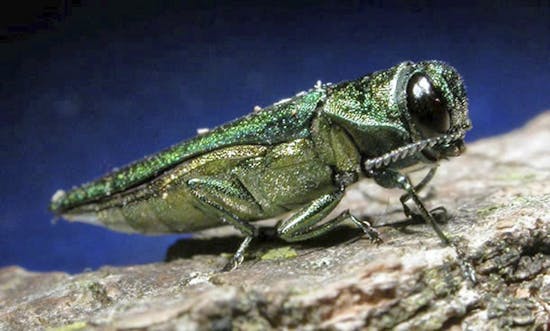Fungi are everywhere. They inhabited the planet long, long before humans showed up. So it's no surprise researchers found thriving communities under the bark of ash trees infested with the emerald ash borer.
What did surprise researchers at the University of Minnesota was the diversity — 173 different kinds of fungi. Some are in cahoots with the beetle and help kill trees, but others attack the beetle itself, feeding on the destructive insect and its eggs.
"It's just incredible, the diversity that's present there," said U forest pathologist Bob Blanchette who is leading the research funded by the university's Minnesota Invasive Terrestrial Plants and Pests Center.
Although the insect-killing fungi are present in the affected trees, they aren't naturally in large enough amounts to control the beetle.
Blanchette's team is studying whether any of the "attack" fungi could be harnessed to effectively fight the invasive beetle threatening nearly 1 billion ash trees across Minnesota. Their findings were published last month in the journal Fungal Biology.
Rachel Coyle, the city of St. Paul's urban forester, called the research "important" and said she's cautiously optimistic it could yield a new tool.
Right now the city's main strategy to control the beetle is aggressively cutting down trees. It also injects trees with an insecticide called emamectin benzoate, one of a handful that work on the beetle.
"There really aren't a lot of management options for the emerald ash borer, unfortunately," Coyle said. "It's exciting to hear that they've done something that could potentially work."
Over the years, the Minnesota Department of Agriculture has released more than 600,000 parasitic wasps in infested areas around the state — including along the Mississippi River in St. Paul — to see whether they can control the beetle's spread. The wasps won't be used on boulevard trees in St. Paul, Coyle said.
They're still not sure the wasps work, said Jonathan Osthus, a research scientist with the state agriculture department. The ash borer is a tough beetle, he said.
The fungi Blanchette's team is focused on are micro fungi. They don't have big fruiting bodies, like the bright-orange chicken of the woods, morels or other mushrooms associated with tree roots in the forest.
The fungi follows the emerald ash borer into trees through the wounds the beetle creates. The beetle's larvae chew the tree's inner bark, leaving long snaking channels called "galleries" in the inner bark, called phloem, that disrupt sap and water.
The fungi thrive in those channels and the phloem and wood around it.
Blanchette's crew took fungi samples from Minnesota trees, incubated them in petri dishes, isolated them and sequenced the DNA. Now they know exactly which fungi follow the beetle around.
They found three main types of fungi: those that cause cankers (dead spots), those that cause rapid decay of the wood and, most importantly, entomopathogenic fungi that attack insects.
Sofia Simeto, a Ph.D. candidate in forest pathology, has been in the lab with a pipette inoculating the tiny eggs of the emerald ash borer with different fungi spores to see which ones are most effective in preventing larvae from developing. The team will also study which ones are effective against the larvae and adult beetles.
Some are very effective at preventing larvae from hatching, Simeto said.
One of the fungal pathogens they found, called Beauveria, has shown potential in research elsewhere to kill adult emerald ash borer beetles.
In nature, the fungi kills the beetles by penetrating the insect's cuticle via specific enzymes. Once they are inside, they can produce toxins and grow very rapidly.
"They colonize the whole insect," Simeto said. "They take the nutrients from the whole insect body and at the very end, which is the last part of the horror movie, they go out again and spread spores."
Simeto likened it to a common kitchen scenario with "mold growing on your lemon."
Blanchette said they'll need to do larger scale evaluations over the next few years to find the right fungi. After that, a company could develop a biocontrol product.
"Once we have something," he said, "I think it would go pretty quickly."
The fungi research has been financed by the lottery-funded Minnesota Environment and Natural Resources Trust Fund.
Jennifer Bjorhus • 612-673-4683





